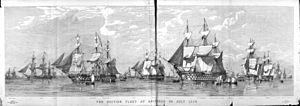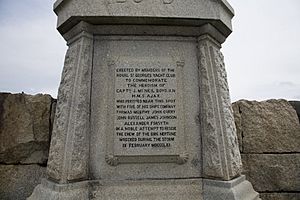HMS Ajax (1809) facts for kids

Ajax as guardship at Kingstown
|
|
Quick facts for kids History |
|
|---|---|
| Name | HMS Ajax |
| Ordered | 1 July 1807 |
| Builder | Perry, Blackwall Yard |
| Laid down | August 1807 |
| Launched | 2 May 1809 |
| Fate | Broken up, 1864 |
| General characteristics | |
| Class and type | Vengeur-class ship of the line |
| Tons burthen | 1761 bm |
| Length | 176 ft (54 m) (gundeck) |
| Beam | 47 ft 6 in (14.48 m) |
| Depth of hold | 21 ft (6.4 m) |
| Propulsion | Sails |
| Sail plan | Full-rigged ship |
| Armament |
|
HMS Ajax was a powerful warship of the Royal Navy, launched on May 2, 1809. It was a "ship of the line," which meant it was big enough to fight in the main battle line of a fleet. This type of ship was known for its many guns, and Ajax carried 74 of them. It was built at Blackwall Yard in London.
Contents
Battles During the Napoleonic Wars
HMS Ajax played an important role during the Napoleonic Wars, a series of major conflicts between France and other European powers.
Action in the Mediterranean Sea
In 1810, while sailing near Elba in the Mediterranean Sea, HMS Ajax was involved in a fight with a French ship. Sadly, a young officer named Charles Benyon was killed during this action.
Later that year, in December, sailors and marines from Ajax and two other British warships, HMS Cambrian and HMS Kent, launched an attack on Palamós in Spain. They aimed to destroy French supply ships. The British landing party successfully destroyed six merchant ships and their escorts. However, the withdrawal was difficult, and the British lost many men killed, wounded, or captured.
Capturing a French Transport Ship
On March 31, 1811, Ajax and another British ship, HMS Unite, met a French group of ships. This group included two frigates and a transport ship called Dromadaire. Ajax managed to capture Dromadaire. The French frigates, however, escaped.
Captain Otway of Ajax reported that Dromadaire was built like a frigate and sailed very well. It was carrying a large cargo of 15,000 cannonballs and shells, plus 90 tons of gunpowder. This cargo was supposedly a gift from Napoleon to the ruler of Tunis. The British decided to buy Dromadaire and its supplies for their own navy.
Capturing the French Brig Alcyon
In 1814, near the Lizard in England, Ajax captured a French brig (a type of two-masted ship) named Alcyon. This French ship had 16 guns and a crew of 120 men. It had only been out of port for a day when Ajax caught it.
Life After the Wars
After the Napoleonic Wars ended, HMS Ajax continued to serve the Royal Navy.
Conversion to a Blockship
In 1846, Ajax was changed into a "blockship." This meant it was converted to have a screw propulsion system, allowing it to be powered by steam as well as sails. These ships were also called 'steam-guard-ships' and were used for coastal defense. During this conversion, parts of the ship were removed to make it more suitable for its new role.
Guardship Duties and the Crimean War
From 1846 to 1853, Ajax was stationed as a guardship in Queenstown, which is now called Cobh in Ireland.

Ajax also took part in the Crimean War (1853–1856). In 1854, it was involved in the Battle of Bomarsund in Finland. After the war, in 1858, it returned to guardship duties. This time, it was stationed in Kingstown, which is now Dún Laoghaire, also in Ireland. It remained there until 1864.
A Heroic Rescue Attempt
While Ajax was in Dún Laoghaire, Captain John McNeil Boyd was its commander. On February 8, 1861, a terrible storm hit the coast. Many ships were lost near Dún Laoghaire. Captain Boyd bravely organized rescue efforts. Sadly, he and five of his crew members were lost during these rescues. Fifteen other crew members from Ajax were given awards for their bravery, and most of them were promoted. There are several memorials dedicated to Captain Boyd and his men.
In December 1863, Ajax itself was driven ashore during a storm in Kingstown but was successfully refloated.
Final Years
In February 1864, it was announced that another ship, HMS Royal George, would replace Ajax as the guardship at Devonport. HMS Ajax was then decommissioned and taken apart later that year.


